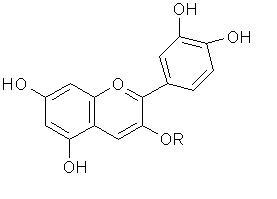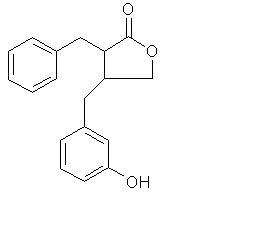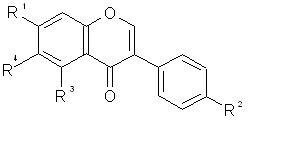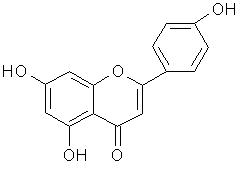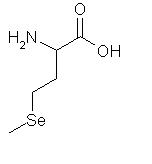在阅读有关癌症的植物辅助治疗之前,请参阅以下内容:
研究表明许多植物产品能够预防和/或治疗癌症。 下面的列表并不是完整的,但它包括了目前科学研究前沿的主要植物产品。
由于那些有助于预防癌症的植物活性化学物质通常就是治疗癌症的化学物质,所以我们将预防和治疗的作用在以下结合描述。
以下是一些植物性治疗,在动物模型(体内)或实验室中的人类细胞(体外)中显示具有癌症治疗的活性。请阅读个人条目以获取预防信息。
以下的植物性治疗,目前没有任何实质性的科学依据证明可以用于癌症治疗。

分类:
植物化学物、多酚、黄酮类
Structure of Anthocyanin
背景和介绍
花青素是一组在蔬菜、柑橘类水果、红葡萄酒,特别是可食用的浆果中的化学物,它赋予许多植物明亮而鲜艳的颜色,如红、蓝、紫色1。花青素可以预防心血管疾病、年龄并发症、肥胖症、炎症、癌症和其他退行性疾病2, 1。此外,它也具有抗氧化的作用,可以保护细胞的DNA2。花青素在食用后很快就会被代谢出体外,目前尚不清楚它们被人体吸收的途径和速度1。 这类化合物可以通过诱导细胞凋亡和抑制增殖来抵抗癌症3。
科学研究
研究表明,花青素可以减缓体外肿瘤细胞的生长4, 5, 6, 7。 由于花青素在动物实验中的作用尚不清楚8,所以目前没有临床试验探究花青素治疗人类癌症的作用。 最近的研究大都集中在研究花青素对于预防癌症而不是治疗癌症的作用,在体外细胞研究中它似乎是没有副作用的9。
目前,一个临床实验研究花青素能否缓解乳腺癌患者对于放疗的副作用正在招募参与者10。 了解更多有关花青素的临床试验,请访问我们的寻找临床实验章节。
美国食品药物管理局批准(FDA)
目前FDA没有批准花青素用于癌症的治疗,因为没有足够的证据支持花青素在抗癌方面的有效性11。
*重要的是,许多癌症治疗包括化疗和放疗,是通过产生自由基来破坏癌细胞的。 如果癌症患者在进行放射治疗或化疗时服用抗氧化剂,那么这些化合物可能会保护肿瘤细胞免受自由基的侵害。 所以医生会建议那些接受化疗和放疗的患者避免使用抗氧化剂,以使治疗尽可能有效12。
菠萝蛋白酶

分类
菠萝蛋白酶是一种植物化学物,是一类在溴氰菊科植物家族(如菠萝)中发现的酶或氨基酸的催化聚合物13。菠萝茎里的菠萝蛋白酶与菠萝果肉里的菠萝蛋白酶并不相同13,尽管在实践中两者都被称为菠萝蛋白酶。
背景和介绍
长期以来,菠萝在南美和东南亚地区一直被用于药用14,在1558年被称为“美国本土最好的药用水果”15。尽管在1891年已经有技术能将菠萝蛋白酶从菠萝中提取出来15,但由于当时菠萝的价格昂贵,并没有商业生产菠萝蛋白酶。在1957年,Heinecke发现被菠萝的茎比果实含有更多的菠萝蛋白酶13,而人们往往只食用果肉却丢弃茎,这为菠萝蛋白酶作为药用化合物的大规模生产铺平了道路。如今,各个美国的营养品商店均销售菠萝蛋白酶补给品,作用于帮助消化,以及其他生物学应用16。
科学研究
科学家对菠萝蛋白酶的研究已经有几十年。研究显示菠萝蛋白酶不仅能有效地对抗炎症14(炎症是引发癌症的主要因素之一),还在体外细胞培养和小鼠模型中显示有抗癌的活性,能够阻断生长并杀死癌细胞17。 所以我们现在知道菠萝蛋白酶是如何阻止癌症的发展18。 菠萝蛋白酶是蛋白酶,它们可以分解细胞表面的蛋白质,影响细胞信号和行为。然而菠萝蛋白酶的生物活性不仅仅是蛋白水解13。
大量的菠萝蛋白酶达到肿瘤部位才会有显著的效果18。 尽管人类能耐受相对高剂量的菠萝蛋白酶而没有副作用16,但是人们很难从药物或食物中获取有疗效的剂量。 因此研究人员正在研究菠萝蛋白酶的纳米颗粒18。
临床实验
目前一个研究菠萝蛋白酶作为抗癌治疗的临床试验正在进行19。另一项试验研究了菠萝蛋白酶与其他化合物一起是否能减少化学疗法的副作用,但目前还未知结果20。
美国食品药物管理局批准(FDA)
目前没有足够证据表明菠萝蛋白酶能够治疗癌症,所有菠萝蛋白酶未被FDA批准用于癌症治疗21。
*有关更多信息,请参阅我们的炎症章节。
姜黄素

分类:
植物化学物、多酚
别名:
Diferuloylmethane

姜黄素的结构
背景和介绍
姜黄素来自姜黄植物(学名:Curcuma longa)。咖喱是一种用于东南亚美食和药物的传统香料,它的黄色就是源于姜黄素22。
亚洲的不同文化已经使用姜黄素有几个世纪。例如,印度药物实践使用姜黄素治疗厌食症,咳嗽,风湿病等疾病23。印度医学仍然使用姜黄素治疗扭伤和肿胀23。传统中药使用姜黄素治疗伴有腹痛的疾病23。西医近来发现姜黄素具有抗炎,抗氧化*,抗细菌,抗毒素和抗HIV活性,以及抗阿尔茨海默病的能力23, 24。
在抗癌方面,姜黄素可诱导细胞凋亡,同时减少血管生成,转移,增生,转化和上皮间质转化25。
观看对Dennis Liotta博士的完整采访:一个艾默里大学的研究人员研发使用姜黄素作为癌症预防和治疗的药物。
科学研究
临床前研究/实验室研究
科学研究发现姜黄素在体外和啮齿动物的实验中有减缓肿瘤细胞生长26和血管生成27的作用。此外,姜黄素似乎能诱导癌细胞凋亡而不伤害健康细胞28。体外癌细胞研究和动物体内研究表明,姜黄素在黑素瘤25,乳腺癌29,结肠癌30, 31,胰腺癌25, 32和头颈癌31等中也具有抗肿瘤作用。
研究表明姜黄素可能具有增强癌症治疗的功效。例如,姜黄素作为促炎蛋白NF-kB的阻断剂,可以防止细胞对化疗产生耐药性33。至于辐射,临床前证据或动物实验研究表明,姜黄素可以通过辐射使癌细胞死亡,并通过辐射保护正常细胞不受伤害34。
2017年6月,一组研究人员测试了不同营养组合对患有前列腺癌小鼠的效果。对前列腺癌细胞影响最大的营养物质包括:苹果皮和迷迭香中熊果酸、姜黄素、白藜芦醇(常见于红葡萄和浆果)。Tiziani曾说过:“这些营养物质具有潜在的抗癌特性,并且很容易获取,所以我们只需要在健康饮食中增加这些物质的剂量就能对前列腺癌细胞产生影响”。35
临床试验/研究
由于一些研究表明姜黄素具有作为抗癌药物的前景,这引起了更多研究者的关注。目前超过50项临床试验正在研究姜黄素治疗和预防癌症的能力,或当姜黄素与其他治疗组合的癌症治疗和预防的效果。大多数试验正在进行,其结果尚未公布36。
研究证明姜黄素在化疗期间可以安全服用37。至于癌症治疗的副作用,口服姜黄素减轻与放疗相关的皮肤问题,如辐射性皮炎和湿性脱屑38, 39,尽管另一项大规模的研究发现这是无统计学意义的改善40。
姜黄素在临床试验中遇到了几个问题,主要是因为它具有较差的生物利用度,也就是说它很难在人体内停留和起作用25, 41。研究人员正在努力通过纳米技术和化学方法稳定分子25, 29, 41,还生产了更多生物可利用的姜黄素类似物37。
有关正在进行的姜黄素的临床试验信息,请访问我们的寻找临床试验章节。
美国食品药物管理局批准(FDA)
目前没有足够的证据证明姜黄素能有效杀死癌细胞,所以FDA并没有批准用于癌症治疗11。但事实上,许多姜黄素产品都在FDA的癌症治疗清单上。
*重要的是,许多癌症治疗包括化疗和放射,是通过产生自由基来破坏癌细胞。如果癌症患者在进行放射治疗或化疗治疗时服用抗氧化剂,则这些化合物可能会保护肿瘤细胞免受自由基的侵害。所以医生一般会建议当病人接受这些治疗时应该避免使用抗氧化剂,以免与治疗相冲克12。
表没食子儿茶素没食子酸酯(EGCG)
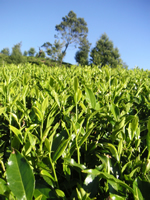


分类:
植物化学物、多酚
别名:
绿茶提取物(epigallocatechin-3-gallate)
Structure of EGCG
背景和介绍
茶是地球上最广泛的饮品之一,仅次于水42。绿茶来自植物Canellia sinesis,一种常绿阔叶菊科植物。绿茶,红茶和乌龙茶都来自这种植物,但它们的准备方式有所不同43。由于绿茶未经过发酵,这保留了茶叶的许多有益特性。一般来说,许多植物含有一种称为多酚的化学物质,可以保护它们免受环境的破坏。多酚EGCG(表没食子隐蛋白-3-没食子酸酯)大量存在于绿茶中42。EGCG具有抗氧化性,并且对皮肤癌、肺癌、食道癌、胃癌、肝癌、小肠癌、胰腺癌、结肠癌、膀胱癌和乳腺癌具有一定的预防作用44, 45。如今全世界都相信茶具有改善血液流动性,消除毒素,增加抗病能力,增加心血管健康,降低胆固醇和预防/防治癌症等众多有益效果。绿茶被发现具有抗氧化*和促进健康的效果,而这主要是由于绿茶含有较高的表没食子儿茶素-3-没食子酸酯(EGCG)42。
科学研究
一些涉及大量人群的研究表明,喝绿茶可以降低某些癌症的风险46。
这些发现是研究绿茶抗癌能力的基础。目前科学家已经发现EGCG可以防止癌细胞获取营养(血管生成)47,导致癌细胞死亡(细胞凋亡)48,阻止癌细胞迁移48,阻止肿瘤生长48,以及抑制细胞增殖49, 48。此外,EGCG仅对癌细胞产生这些作用,不会影响正常细胞48,所以使用EGCG时非常安全的。
目前已经有许多临床试验来研究EGCG预防癌症的能力,但结果不尽相同。一项研究发现,EGCG能减少前列腺癌组织中的氧化作用和NF-kB含量(NF-kB是一种重要的炎症蛋白),但EGCG对凋亡或增殖没有显著影响50。在另一项乳腺癌患者的研究中,EGCG没有显着降低VEGF和HGF(血管发生和增殖的标志物)51,但在前列腺癌患者中,EGCG却显著降低VEGF和HGF的含量52。许多其他的研究正在进行中,例如一项试验正在研究绿茶提取物是否能治疗膀胱癌患者53。
有关EGCG的更多临床试验的信息,请访问我们的寻找临床实验章节。事实上许多茶叶产品都在FDA的癌症治疗清单上。
美国食品药物管理局批准(FDA)
目前没有足够的证据表明EGCG在抗癌方面是有效的,所以FDA并没有批准用于癌症治疗54。
*重要的是,许多癌症治疗包括化疗和放射,是通过产生自由基来破坏癌细胞。如果癌症患者在进行放射治疗或化疗治疗时服用抗氧化剂,则这些化合物可能会保护肿瘤细胞免受自由基的侵害。所以医生一般会建议当病人接受这些治疗时应该避免使用抗氧化剂,以免与治疗相冲克12。
请阅读我们关于补给品治疗的信息。为了更好地理解和评估上述研究,请阅读我们的科学研究简介。
番茄红素

分类
植物化学物、类胡萝卜素
背景和介绍
番茄红素是西红柿(学名Solanum lycopersicum)表皮红色的来源。55 西瓜,葡萄柚,番石榴和番木瓜也含有这种番茄红素,但含量相对西红柿较低。 长期以来,食用这种抗氧化剂能够降低前列腺癌的风险。56 关于番茄红素的大多数研究涉及前列腺癌预防。研究还表明,从番茄中摄取番茄红素,比吃补品更有效。57
科学研究
体外试验的结果令人鼓舞。例如,用一种番茄红素含量较高的番茄(Racimo)辅助治疗可以阻止结肠直肠癌细胞的生长,58 并且当用番茄红素处理前列腺癌细胞时,大量的癌细胞被诱导至细胞凋亡。59 番茄红素也显示抑制体内前列腺癌细胞的生长,这是番茄红素通过增加BCO2酶的表达而完成的,BCO2是一种降低NF-κB活性的肿瘤抑制因子)。60 然而,番茄红素只作用于需要雄性激素生长的细胞(称为“雄激素敏感性”)。60, 61
番茄红素在体内测试中也证明抑制前列腺癌细胞的生长。62 例如,一项在老鼠的研究表明,番茄粉抑制了癌细胞的产生,延长了动物的存活期,并降低了动物的死亡率。63
番茄红素是预防和治疗前列腺癌的许多II期临床试验的焦点。虽然一些试验已经公布了结果,但结果不是很有利或者不好应用。64, 65, 57
一项比较番茄汁和橘子汁如何阻止前列腺癌进展的试验正在招募参与者。66 有关番茄红素的临床试验信息,请访问我们寻找临床试验的章节。
总之,虽然临床前的证据是有利的,但是目前任然没有足够的证据来证明番茄红素是否能有效治疗癌症。
了解更多关于细胞凋亡和癌症。
推荐阅读
美国国家癌症研究所发表了一篇关于前列腺癌的医师数据查询(PDQ)摘要,其中包括一个章节有关番茄红素。
美国食品药物管理局批准(FDA)
目前没有足够的证据表明番茄红素在抗癌方面是有效的,所以FDA并没有批准用于癌症治疗11。但事实上,一个番茄红素的产品列在FDA的癌症治疗清单上。
*重要的是,许多癌症治疗包括化疗和放射,是通过产生自由基来破坏癌细胞。如果癌症患者在进行放射治疗或化疗治疗时服用抗氧化剂,则这些化合物可能会保护肿瘤细胞免受自由基的侵害。所以医生一般会建议当病人接受这些治疗时应该避免使用抗氧化剂,以免与治疗相冲克12。
请阅读我们关于补给品治疗的信息。为了更好地理解和评估上述研究,请阅读我们的科学研究简介。
植物雌激素
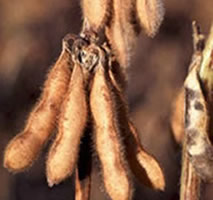
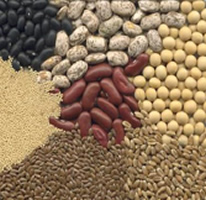
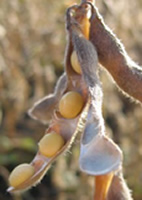
分类
植物化学物, 植物雌激素, 异黄酮
植物雌激素类型
异黄酮(例如染料木黄酮, 大豆甙元, 黄豆黄素, 角叉菜胶)67
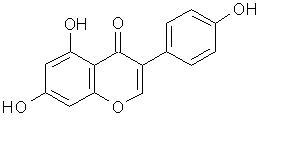
染料木黄酮的结构(Genistein) 大豆甙元的结构(Daidzein)
木酚素(例如,二异恶唑烷醇,马来西林醇,松油醇,苎麻油醇)67
木酚素的结构(Lignan)
钴胺(例如香豆雌酚)68
钴胺的结构(Coumestan)
异黄酮
异黄酮的结构(Isoflavonoids)
黄酮类(黄烷醇, 黄酮酮, 黄酮, 黄酮醇)68
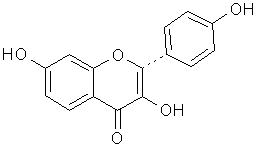
黄酮醇的结构(Flavonol) 黄酮的结构(Flavone)
背景知识
植物雌激素涵盖了大量来自植物,天然存在于食物中的化合物。植物雌激素主要包括异黄酮、木质素和香豆素, 常见于大豆、豆类、肉类、谷物、坚果、水果和蔬菜中。木质素在多数亚麻籽植物中发现含量最高。67 香豆素存在于斑豆,苜蓿芽,植物中。69
植物雌激素被发现具有抗氧化性质。70 因为抗氧化与细胞健康与存活密切相关, 这一发现使得有些人相信植物雌激素可以被用作预防和治疗癌症。71 植物雌激素被认为具有抗癌功效的另一原因是在亚洲国家乳腺癌和前列腺癌的发生率较低。相比西方国家,在亚洲国家的人们摄取更多蔬菜黄豆中存在的植物雌激素,可能因此导致了乳腺癌和前列腺癌的相对较低发生率。72
这些化合物同时被认为可以阻止癌症生长由于它们的结构与类固醇激素如雌激素和睾酮相似。雌激素是已知的一种激素应答性癌症的引发物,如乳房癌,子宫癌,子宫内膜癌。
由于植物雌激素与雌激素的结构十分相似,植物雌激素结合到雌激素的分子受体上,因此雌激素不能与它的分子受体结合,从而减少细胞内的致癌信号。73 研究人员认为,这类化合物也可能参与调节细胞死亡(细胞凋亡)。70 目前研究人员正在研究植物雌激素是否能预防心血管疾病,骨质疏松症和更年期症状。67
科学研究
尽管90年代早期和中期的老年人群研究表明,植物雌激素含量较高的饮食能减少与激素相关的癌症,但最近的研究显示相矛盾的结果,植物雌激素对抗癌症的有效性并不显著。74
植物雌激素可以抑制癌症转移,75 这是癌症发展的关键。根据一项研究表明,高剂量的大豆植物雌激素(染料木黄酮)可以减缓体外试验中一种小鼠癌细胞的生长。76 在另一项研究中,大豆植物雌激素(染料木黄酮和大豆甙元,如上所示,以及甘油磷脂)的组合能有效阻止前列腺癌细胞在体外试验中生长。77 另一个研究小组得出的结论是,香豆雌酚通过与铜相互作用而导致癌细胞死亡并破坏细胞DNA,前提是癌细胞含有较高水平的铜。78 含有植物雌激素的亚麻籽油也显示在体外和小鼠中有预防与雌激素相关的肿瘤细胞生长的作用。79 此外,一项初步研究发现,植物雌激素和纤维的组合与COX-2抑制剂一样有效,COX-2抑制剂可阻断一个对结肠直肠癌重要的酶。研究得出的结论是,植物雌激素/ 纤维膳食补给品可以预防家族性腺瘤性息肉病患者的结肠直肠癌的发展。80
研究支持植物雌激素在辅助治疗中的作用;研究表明染料木黄酮可预防化疗引起的骨骼损伤。81 目前一项临床试验正在招募参与者,这项试验研究染料木黄酮是否能改善结直肠癌患者化疗的有效性。82
另一方面,植物雌激素也被怀疑会导致癌症和异常的胎儿发育。72 一些研究表明,植物雌激素可以增加体外试验中乳腺癌细胞的生长。74, 83 一些欧洲国家甚至推荐限制每天摄入大豆的最大量。72
目前,研究人员正在进行多项临床试验,旨在调查植物雌激素在化学预防中的潜在作用。74 一项二期临床试验显示,染料木黄酮可降低膀胱癌患者中参与癌细胞生长的重要受体EGFR的激活。 该研究发现其他标记物没有显着差异。84 一些其他试验正在研究植物雌激素是否可通过膳食补给品来降低前列腺癌的发展。85, 86 有关正在进行的植物雌激素的临床试验的信息,请访问我们关于寻找临床试验的章节。
推荐阅读
美国国家癌症研究所已经出版了专门为患者编写的关于大豆和前列腺癌的医师数据查询(PDQ)总结。
美国食品药物管理局批准(FDA)
目前没有足够的证据表明番茄红素在抗癌方面是有效的,所以FDA并没有批准用于癌症治疗。11
*重要的是,许多癌症治疗包括化疗和放射,是通过产生自由基来破坏癌细胞。如果癌症患者在进行放射治疗或化疗治疗时服用抗氧化剂,则这些化合物可能会保护肿瘤细胞免受自由基的侵害。所以医生一般会建议当病人接受这些治疗时应该避免使用抗氧化剂,以免与治疗相冲克。12
请阅读我们关于补给品治疗的信息。为了更好地理解和评估上述研究,请阅读我们的科学研究简介。
碧萝芷
碧容健的结构
分类
植物化学物, 多酚,类黄酮,原花青素
背景和介绍
碧萝芷是一种来自法国松树(Pinus pinaster)的树皮衍生产品。87 从这棵树的树皮中提取的化合物含有类黄酮(flavonoids),原花青素(procyanidins)和原花色素(proanthocyanidins)的化合物,这些化合物也在葡萄和可可中被发现。88, 89 这种提取物在欧洲被广泛用作保护神经细胞,增加精子活力,增加组织功能,降低血压和缓解哮喘症状的膳食补给品。87 研究人员正在研究碧萝芷和其他原花色素的抗氧化,抗炎和抗血小板功能。88, 90, 89
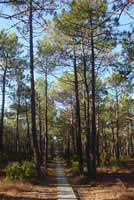
法国松树
科学研究
这种天然提取物被认为能够减少氧化性损伤,并防止一些导致癌症的过程。91 碧萝芷在体外还可以诱导细胞凋亡并减缓口腔癌,92, 93 白血病,94 乳腺癌95 和卵巢癌96 细胞的繁殖。97 台湾短松(Pinus morrisonicola)的相关树种的混合物也显示在体外试验中有杀死白血病细胞的能力。98
碧萝芷还可以减缓体内试验中皮肤癌的发展。89 更重要的是,即使被人体代谢或处理的碧萝芷,也会导致纤维肉瘤细胞死亡。99 大部分有关碧萝芷和原花青素的研究都涉及到预防癌症的能力。然而,有一个研究小组报道,碧萝芷可以治疗中度但不严重的口腔粘膜炎,这是化疗的一个痛苦的副作用,可能会影响患者恰当的营养摄取。100
威斯康星大学(University of Wisconsin)和国家补充与整合健康中心(National Center for Complementary and Integrative Health)共同发起的一项临床研究调查了碧萝芷是否能够使患有淋巴水肿的乳腺癌幸存者受益,以及是否能缓解乳腺癌的一个常见的副作用:淋巴结内累积液体。101 有关正在进行的碧萝芷的临床试验的信息,请访问我们关于寻找临床试验的章节。
美国食品药物管理局批准(FDA)
目前没有足够的证据表明碧萝芷在抗癌方面是有效的,所以FDA并没有批准用于癌症治疗。11
*重要的是,许多癌症治疗包括化疗和放射,是通过产生自由基来破坏癌细胞。如果癌症患者在进行放射治疗或化疗治疗时服用抗氧化剂,则这些化合物可能会保护肿瘤细胞免受自由基的侵害。所以医生一般会建议当病人接受这些治疗时应该避免使用抗氧化剂,以免与治疗相冲克。12
请阅读我们关于补给品治疗的信息。为了更好地理解和评估上述研究,请阅读我们的科学研究简介。
白藜芦醇
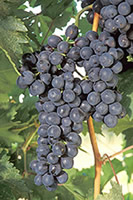
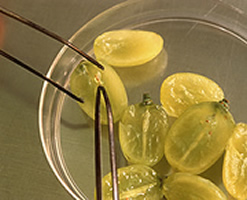

分类
植物化学物,多酚,植物雌激素,花青素
Structure of Resveratrol
背景和介绍
白藜芦醇是一种常见于红葡萄皮和种子中的化合物,它也可以从浆果,坚果,葡萄酒和补给品中获取。102, 103 在植物中,这种化合物有助于抵御真菌感染。104
在1925年,白藜芦醇的癌症治疗始于南非的一位营养师约翰娜·勃兰特(Johanna Brandt),她声称通过饮食葡萄可以治愈自己的胃癌。105 她在1928年在纽约市开办了和谐医疗中心,但被迅速控告无证执业。106, 107 美国癌症协会四次检查了勃兰特的葡萄治疗,并没有发现其使用的治疗价值。关于白藜芦醇的另一个有趣的事件是“法国悖论”:法国人通常吃高脂肪的饮食,但他们的心脏病的发病率却不高。108
科学家们研究这种化合物由于它的抗氧化活性,109 因为它可能会干扰血管生成和转移,110 同时诱导癌细胞凋亡。102 研究人员也正在研究白藜芦醇潜在的预防癌症,保护内皮细胞111 和预防心脏病的能力。102 当使用补给品时,白藜芦醇在动物试验中没有表现出不利的副作用。110
科学研究
一些体外研究表明白藜芦醇可以诱导癌细胞凋亡112并减少癌细胞生长102。涉及小鼠的实验也表明白藜芦醇可以诱导癌细胞凋亡。113 此外白藜芦醇还可以抑制上皮细胞 - 间充质转化,氧化应激和炎症等过程,这些都涉及癌症的发展。114, 75白藜芦醇也被证明可以调节癌症干细胞的进展,阻止它们发展成肿瘤。 然而,一些体外实验显示白藜芦醇能够增强化疗药物雷帕霉素(rapamycin)的抗肿瘤生长作用。 这些实验结果还表明癌细胞对雷帕霉素药物的抵抗力减弱,这可能是白藜芦醇抑制AKT信号传导的结果115。
另外,研究显示白藜芦醇可以在体外刺激乳腺癌细胞生长。103 然而,由于患者数量较少,研究设计上的差异以及治疗时间较短,研究人员尚未在白藜芦醇以及类似分子对治疗癌症的能力上得出结论。116 尽管有这些令人鼓舞的结果,但白藜芦醇,和姜黄素一样,不容易被人体吸收,所以高浓度摄取才能得到显著的结果。114 因此,尽管实验室研究表明白藜芦醇可以预防癌症进展,但临床试验的结果并没有如此好的前景。114, 117
加州大学欧文分校,国立癌症研究所,奥斯陆大学,威斯康星大学和密歇根大学的临床研究正在研究白藜芦醇如何有效地治疗癌症。118 在加州大学欧文分校的试验中,白藜芦醇能够负面影响结肠癌发展的途径。119 这项试验和NCI试验一起表明,白藜芦醇在预防癌症的方面发挥作用,但不能帮助治疗癌症。120 有关正在进行的白藜芦醇临床试验的信息,请访问我们的关于寻找临床试验的部分。
2017年6月,一组研究人员测试了小鼠前列腺癌细胞对不同营养组合的反应。 其中,对前列腺癌细胞影响最大的营养素包括:在苹果皮和迷迭香中发现的熊果酸;姜黄素;红葡萄和浆果中的白藜芦醇。Tiziani表示:“这些营养素具有潜在的抗癌特性,并且容易获得。 我们只需要摄入更多这些营养素,就能帮助抵抗前列腺癌细胞对患者的影响。” 35
美国食品药物管理局批准(FDA)
目前没有足够的证据表明白藜芦醇在抗癌方面是有效的,所以FDA并没有批准用于癌症治疗。11
*重要的是,许多癌症治疗包括化疗和放射,是通过产生自由基来破坏癌细胞。如果癌症患者在进行放射治疗或化疗治疗时服用抗氧化剂,则这些化合物可能会保护肿瘤细胞免受自由基的侵害。所以医生一般会建议当病人接受这些治疗时应该避免使用抗氧化剂,以免与治疗相冲克。12
请阅读我们关于补给品治疗的信息。为了更好地理解和评估上述研究,请阅读我们的科学研究简介。
硒
通常以硒代蛋氨酸的形式摄入
硒代蛋氨酸的结果
背景和介绍
硒是氨基酸—硒代蛋氨酸的组成部分,常见于土壤,饲料和谷物。121 这种天然存在的氨基酸对健康饮食是必不可少的,人们通常从肉类,海鲜和植物中获取。122, 123 植物,动物和人体中硒的含量取决于他们所在地区土壤中的硒浓度。当一份报告显示平均硒摄入量较低的国家一般有较高的癌症风险,调查人员开始将硒作为一种抗癌药。124
在许多研究中,研究人员还结合硒和维生素E,以调查他们的抗癌能力。在大多数情况下,研究的重点是硒的预防癌症的能力,而不是治疗癌症的能力。它的确切作用机制还是未知的,但它可能通过几种不同的方式与致癌过程作斗争:它增强了通常对抗癌细胞的机制,并防止有害分子结合并改变DNA。125
美国食品和药物管理局建议成年人每日摄入硒的含量大约70微克(最多400微克/天),作为正常、健康饮食的一部分。126, 123
科学研究
硒可能是预防癌症的有效药物,但在作出结论之前需要更多的研究。127, 128 一些研究表明一定水平的硒摄入可以防止癌症发展。129, 123 研究还表明,当男性将硒纳入他们饮食的一部分时,他们患前列腺癌的风险降低。126 当前列腺癌细胞在体外加入硒时,肿瘤生长被抑制并且发生细胞凋亡。121, 130 研究发现富含硒的糖有抗癌作用,131 如含硒化合物Se,Se'-1,4-phenylenebis(1,2-ethanediyl) bisisoselenourea,对于治疗肝癌有作用。132 硒的离子化合物—亚硒酸钠也被证明可以帮助治疗由放疗和手术引起的淋巴水肿或淋巴结肿大。133 而且,据报道甲基硒醇可以减缓小鼠结肠肿瘤的生长。134
有迹象表明,硒可能会增加二型糖尿病的风险。129
一个二期临床试验正在研究硒对预防和治疗癌症的能力。尽管一些试验已经完成,但结果尚未公布。有关硒的临床试验的更多信息,请访问美国数据库。 有关正在进行的临床试验的信息,请访问我们的关于寻找临床试验的部分。
推荐阅读
美国国家癌症研究所已经出版了专门为患者编写的关于硒和前列腺癌的医师数据查询(PDQ)总结。
美国食品药物管理局批准(FDA)
目前没有足够的证据表明硒在抗癌方面是有效的,所以FDA并没有批准用于癌症治疗。11
请阅读我们关于补给品治疗的信息。为了更好地理解和评估上述研究,请阅读我们的科学研究简介。
大麻和大麻籽油
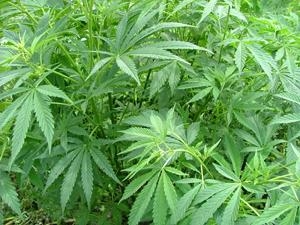
分类: 植物化学物, 芳香萜类
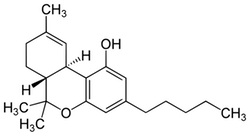
背景和介绍
大麻是一种大麻科植物,其中包括大麻苜蓿(见上图,图片来自于维基百科),大麻籼稻和莠草大麻。135 大麻是在大麻植物中发现的化学物质。大麻素与靶细胞上的受体蛋白结合可以产生多种作用。动物也可生成大麻,这些大麻是根据其来源来分类。植物大麻素 (Phytocannabinoids) 由植物产生,而内源性大麻素 (endocannabinoids) 在人类和动物中天然存在,此外也有人造的合成大麻素。现在植物中天然存在的许多大麻素可以被合成生产。在大麻中发现的两种主要大麻素是四氢大麻酚(tetrahydrocannabinol,THC),又称9-四氢大麻酚(β-9-THC) (如上图所示) 和大麻二酚(CBD)。136, 137 THC是一种主要的精神活性成分,它与中枢神经系统中的CB1和CB2受体结合,并在大麻(Cannabis sativa)中发现。 THC被认为是大麻使用者感到欣快和放松的原因。136, 137 另一方面,CBD对CB1和CB2受体的亲和力低,虽然其作用方式不太清楚,但研究表明CBD对人体产生抗精神病和抗焦虑作用,并减轻THC在人体内的作用。138 目前,研究人员正在研究这些大麻素用于治疗几种不同癌症的潜在用途。在下面看到更多细节。139, 140, 141, 142, 143
大麻籽油
大麻油是一个常用的非科学术语,来形容由许多不同的大麻种类制成的提取物。 大麻油是在大麻籽被压榨时获得的。 大麻油在美国是合法的。 现代大麻油制造方法确保了大麻油中几乎没有THC。 用于制造大油类的种子来自大麻苜蓿品系,其中只含有少量的四氢大麻酚。144, 145
科学研究
研究显示大麻对体外和体内的细胞生长有很多不同的影响。以下列举了其中一些大麻的作用。有一些结果是相互矛盾的,例如一个研究结果表明大麻对抗癌的有益,而另一个研究结果显示没有益处,或者更糟,大麻可能导致癌细胞更加积极地生长或蔓延。
在实验室培养皿中培养的细胞(也称为细胞培养或体外培养)
- 人造合成的化学物能激活与大麻素相同的受体,这些化学物可以抑制肺癌细胞和乳腺癌细胞的入侵行为。140, 141
- 活化与大麻素相同的受体的人造(合成)化学品显示出抑制肺癌细胞和乳腺癌细胞的侵袭行为。
在苜蓿(Δ9-THC)中发现的主要精神活性大麻素中,研究人员对不同乳腺癌细胞的研究表明,该化学物质不能杀死细胞。 相反,这种天然的产物实际上增强了动物癌细胞的生长。142
在动物中研究(也称为体内)
与大麻素受体结合的合成化学物质显示有减少在小鼠中生长的肺癌细胞,这些化学物质似乎通过阻断“存活”蛋白AKT的活性而导致癌细胞死亡。140
- 同样在小鼠的研究中,相同的化学物质显示有减少乳腺癌的生长和扩散。141
- 在一项研究天然化合物Δ9-THC的试验中,结果显示该化合物增加肿瘤生长,肿瘤生长的增加是由于免疫系统受到 Δ9-THC的抑制。142
在人体内研究
- 在一项试验中,Δ9-THC注射入9例脑胶质细胞瘤患者的大脑内。 试验结果表明,在一些患者中,这种药物在体外和体内都能减少癌细胞的分裂,尽管患者并没有从疾病中恢复过来。146
- 在另一项试验中,参与者给予喷雾剂注射 Δ9-THC和cannabidiol ,项目时长5周,剂量为每天1-4次,6-10次,或11-16次喷雾,第四组给予安慰剂。 与安慰剂组相比,低剂量(1-4次喷雾剂)组表示疼痛感显著下降。147
在一些系统中看到的相互矛盾的结果是由不同剂量的大麻素引起的不同效应。这在2009年的一篇名为“大麻素治疗癌症”的综述中被深入报道。139 最近也有几篇论文关于大麻素和内源性大麻素在癌症的作用。148, 149
在2013年发表的研究表明,Δ9-THC 的抗癌活性在很大程度上是由于它对假磷酸甘油酯同系物-3(TRIB3)蛋白质的作用引起的。 TRIB3是应激反应系统的一部分,当有更高水平的TRIB3时,它能阻断保持细胞活性的蛋白质(包括AKT和mTOR)。 Δ9-THC能增加TRIB3的水平并导致癌细胞死亡。如果缺失TRIB3,Δ9-THC并不能杀死细胞,这显示这种蛋白质在Δ9-THC的作用中的重要性。150 由于大麻素受体的分子机制仍在研究之中,因此需要进一步研究Δ9-THC和其他大麻素对各种癌症的作用。
没有研究足够显示在大麻或大麻油发现的Î9-THC或其他大麻素能够治疗任何形式的癌症。
研究大麻也有其他原因。它们可以帮助减轻癌症的影响和癌症治疗的副作用,如疼痛,恶心和食欲不振(厌食症)。148, 151, 152, 149, 153 它们还可以在神经胶质瘤中提高辐射的有效性。154
推荐阅读
美国国家癌症研究所已经出版了专门为患者编写的关于大麻和大麻油的医师数据查询(PDQ)总结。
点击寻找更多大麻素对于癌症作用的研究 (打开新窗口 - 只需在搜索栏中输入这些字词)
美国食品药物管理局批准(FDA)
目前没有足够的证据表明大麻在抗癌方面是有效的,所以FDA并没有批准用于癌症治疗。11 但是一些合成大麻,如nabilone 和 dronabinol被批准用于治疗化疗引起的恶心和呕吐。155
请阅读我们关于补给品治疗的信息。为了更好地理解和评估上述研究,请阅读我们的科学研究简介。
Essiac®, Flor-Essence®
背景和介绍
Essiac®是四种草药的混合物:牛蒡根(牛蒡子),印度大黄(Rheum palmatum),酢浆草(Rumex acetosella)和榆树(Ulmus fulva或U. rubra)的内部树皮。156 Flor-Essence®包含以上四种草药以及红三叶草(Trifolum pretense),祝福蓟(Carduus benedictus),海带(Laminaria digitata)和豆瓣(Nasturt officinale)。157 Ojibwa土著美洲部落的药师被认为是Essiac®的创造者。158 在20世纪20年代初,加拿大护士Rene Caisse开始用草药混合物治疗病人,159 此后这种治疗开始流行起来。她声称Essiac®改善了病人的生活质量,延长了生存期,甚至可以治愈癌症。而Essiac®也是根据她的名字命名的。160 癌症患者使用这些产品很大程度上是由于传闻这些药物可以治疗或预防癌症,而这只是少数情况。据称,这也是过敏,高血压和骨质疏松症的补救措施。161
科学研究
Essiac®被证明可以阻断自由基,并且具有保护DNA免受损害而导致癌症的能力。162 此外,研究人员发现Essiac®可以防止前列腺癌细胞在体外生长。158 另一项研究表明,Essiac®和Flor-Essence®在体外对白血病和乳腺癌细胞的生长只有微弱的作用,且浓度仅高于体内一点点。这项研究还发现,混合药草增加癌细胞分化。此外,另一项研究发现,Essiac®和Flor-Essence®不仅不能阻止肿瘤的扩大,反而可能刺激乳腺癌细胞的体外生长。157 涉及Essiac的临床试验发现,它对乳腺癌妇女的生活质量没有影响。163
目前还没有积极的临床试验来研究Essiac®或Flor-Essence®的抗癌能力。164 有关正在进行的涉及Essiac®或Flor-Essence®临床试验的信息,请访问我们关于寻找临床试验的部分。
推荐阅读
美国国家癌症研究所已经出版了专门为患者编写的关于Essiac® and Flor-Essence®的医师数据查询(PDQ)总结。
美国食品药物管理局批准(FDA)
目前没有足够的证据表明Essiac® and Flor-Essence®在抗癌方面是有效的165,所以FDA并没有批准用于癌症治疗。166 其实Essiac是在FDA虚假抗癌物的名单上。Essiac®和Flor-Essence®在商业上是可以买到的,因为它们可以作为膳食补充剂销售,膳食补充剂不需要FDA的批准,除非卖方声称他们可以治愈或预防疾病。167
请阅读我们关于补给品治疗的信息。为了更好地理解和评估上述研究,请阅读我们的科学研究简介。
格森疗法 (Gerson Therapy)
根据该公司的网站,格森疗法的目标是使用“有机,素食,生果汁,咖啡灌肠和天然补品”等来治疗癌症等慢性疾病。 目前两家诊所有执照去使用这种疗法,一个在匈牙利,一个在墨西哥。168
但是,FDA尚未批准格森疗法,科学文献也没有对其在临床前研究(动物或实验室)有过报道。 然而,这种疗法在一些临床研究(涉及人类)中使用过,其中大多数是Gerson博士发表的案例研究,但他们没有提供有关治疗方案的确凿证据。169
欲了解更多信息,请参阅美国国家癌症研究所的医师数据查询 (PDQ) 关于格森疗法的癌症信息摘要。
请阅读我们关于补给品治疗的信息。为了更好地理解和评估上述研究,请阅读我们的科学研究简介。
刺果番荔枝(Graviola)
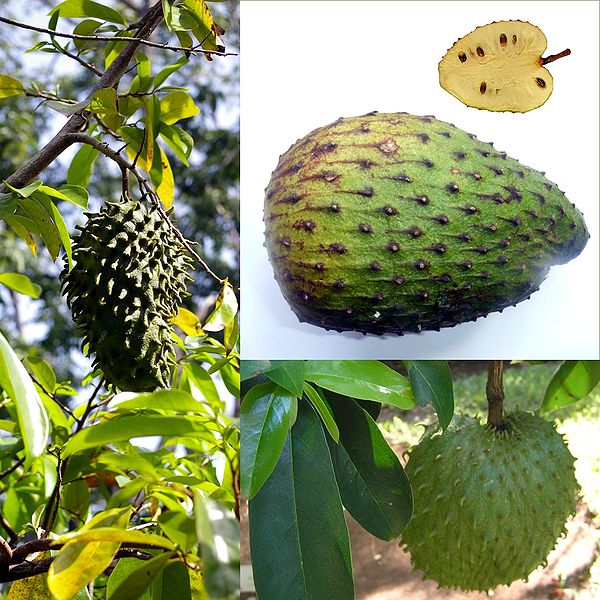
Image obtained from Wikimedia.
分类
植物化学物
背景和介绍
刺果番荔枝(又名soursop guyabano和guanábana)通常是指热带树Annona muricata的果实。有时它被称为巴西爪爪或奶油苹果 - 虽然它们并不一样。传统上使用刺果番荔枝的树皮,叶,根和果实的提取物来治疗各种疾病,包括细菌感染,疱疹病毒感染和癌症。然而,很少有科学研究测试了提取物的药用性质。170, 171
刺果番荔枝的叶子含有长链脂肪酸的衍生物,被称为番荔枝内酯(annonaceous acetogenins)172, 173, 171, 据说它是通过抑制细胞能量载体三磷酸腺苷(ATP)的产生而发挥其少部分的生物效应。174, 175 由于癌细胞比正常细胞需要更多的ATP,因此认为番荔枝内酯通过消耗它们的能量来诱导癌细胞的死亡。 刺果番荔枝中的化学物质也被证明可以抑制DNA的产生复制。176, 177
科学研究
在实验室研究中,刺果番荔枝的提取物被证明会导致胰腺癌细胞系(FG / COL0357和CD18 / HPAF)的功能受损和死亡。在免疫功能低下的小鼠中,口服刺果番荔枝提取物可减少注射胰腺癌细胞的生长和扩散。175 另一项研究报道表明,它可以通过降低癌细胞繁殖能力来防止胰腺癌进展到更危险的阶段。178 根据最近的体外研究,它也可以杀死鳞状细胞癌细胞。179
在使用过量表达EGFR的人乳腺癌细胞(MDA-MB-468)的体外和体内研究中,刺果番荔枝果实提取物也显示下调表皮生长因子受体(EGFR)癌基因并抑制乳腺癌细胞生长。然而,提取物对非致瘤性人乳腺上皮细胞没有影响。180 在体内研究中,6-7周龄的小鼠注射刺果番荔枝可引发并加速皮肤癌生长。研究人员还将番荔枝(Annona muricata)的提取物涂在一些小鼠的皮肤上以查看提取物是否可以减缓或防止皮肤癌的生长。 最高剂量的刺果番荔枝提取物可以抑制肿瘤的生长。在这个简短的研究中,小鼠没有出现刺果番荔枝的副作用。181
至于在人体中的研究中,一个0期(Phase 0 )临床试验已经结束,其中结肠直肠癌患者被给予含有刺果番荔枝的提取物,但结果不可用。182
副作用
虽然一些研究表明,刺果番荔枝提取物可能具有抗癌效果,提取物的主要生物活性成分-番荔枝内酯也可能引起神经系统错乱或精神问题,包括一种非典型的帕金森病。183, 184, 185, 186, 187 在大鼠静脉内给予番荔枝内酯28天的研究中,研究人员观察到大鼠的脑ATP水平异常减少,这与非典型帕金森患者相似。188
一些研究表明,刺果番荔枝(soursop)中的化学物质可能是有毒的。 应该谨慎使用。
美国食品药物管理局批准(FDA)
目前没有足够的证据表明刺果番荔枝在抗癌方面是有效的,所以FDA并没有批准用于癌症治疗。11
请阅读我们关于补给品治疗的信息。为了更好地理解和评估上述研究,请阅读我们的科学研究简介。
- 1abc Prior RL, Wu X. Anthocyanins: structural characteristics that result in unique metabolic patterns and biological activities. Free Radic Res. (2006) 40(10): 1014-28 [PUBMED]
- 2ab Zafra-Stone S, YAsmin T., Baqchi M., Chatterjee A., Vinson J.A., Bachi D.Berry anthocyanins as novel antioxidants in human health and disease prevention. Molecular Nutrition & Food Research. (2007) 51:6, 675-683 [PUBMED]
- 3 Wu QK, Koponen JM, Mykkanen HM, Torronen AR. Berry phenolic extracts modulate the expression of p21(WAF1) and Bax but not Bcl-2 in HT-29 colon cancer cells. J Agric Food Chem. (2007) 55(4): 1156-63 [PUBMED]
- 4 Valcheva-Kuzmanova S.V., Belcheva A. Colon-available raspberry polyphenols exhibit anti-cancer effects on in vitro models of colon cancer. Journal of Carcinogenesis (2007) Apr 18; 6: 4 [PUBMED]
- 5 Ferguson, P. J.; Kurowska, E.; Freeman, D. J.; Chambers, A. F.; Koropatnick, D. J. A flavonoid fraction from cranberry extract inhibits proliferation of human tumor cell lines. Journal of Nutrition. 2004, 134, 1529-1535. [PUBMED]
- 6 Seeram, N. P.; Adams, L. S.; Hardy, M. L.; Heber, D. Total cranberry extract versus its phytochemical constituents: antiproliferative and synergistic effects against human tumor cell lines. Journal of Agric. Food Chem. 2004, 52, 2512-2517 [PUBMED]
- 7 Anwar S, Fratantonio D, Ferrari D, Saija A, Cimino F, Speciale A. Berry anthocyanins reduce proliferation of human colorectal carcinoma cells by inducing caspase-3 activation and p21 up regulation. Mol Med Rep. 2016 Jun 13. [PUBMED]
- 8 Neto CC. Cranberry and blueberry: Evidence for protective effects against cancer and vascular diseases. Molecular Nutrition & Food Research. (2007) 51(6): 652-664. [PUBMED]
- 9 Stopper H, Schmitt E, Kobras K. Genotoxicity of phytoestrogens. Mutat Res. (2005) 574(1-2):139-55 [PUBMED]
- 10 Neuromed IRCCS. Supplementation With Dietary Anthocyanins and Side Effects of Radiotherapy for Breast Cancer (ATHENA). Apr 2015. [https://clinicaltrials.gov/ct2/show/NCT02195960?term=NCT02195960&rank=1]
- 11abcdefghi US Food and Drug Adminstration website. Accessed 6/20/2016. [http://www.fda.gov/]
- 12abcdefg Borek C. Dietary antioxidants and human cancer. Integr Cancer Ther (2004). 3: 333-341. [PUBMED]
- 13abcd de Lencastre Novaes LC, Jozala AF, Lopes AM, de Carvalho Santos-Ebinuma V, Mazzola PG, Pessoa Junior A. Stability, purification, and applications of bromelain: A review. [PUBMED]
- 14ab Chobotova K, Vernallis AB, Majid FA. Bromelain's activity and potential as an anti-cancer agent: Current evidence and perspectives. Cancer Lett. 2010 Apr 28;290(2):148-56. [PUBMED]
- 15ab Taussig SJ, Batkin S. Bromelain, the enzyme complex of pineapple (Ananas comosus) and its clinical application. An update. J Ethnopharmacol. 1988 Feb-Mar;22(2):191-203. [PUBMED]
- 16ab Hale LP. Proteolytic activity and immunogenicity of oral bromelain within the gastrointestinal tract of mice. Int Immunopharmacol. 2004 Feb;4(2):255-64.
- 17 Amini A, Masoumi-Moghaddam S, Ehteda A, Morris DL. Bromelain and N-acetylcysteine inhibit proliferation and survival of gastrointestinal cancer cells in vitro: significance of combination therapy. J Exp Clin Cancer Res. 2014 Nov 12;33:92. [PUBMED]
- 18abc Bhatnagar P, Pant AB, Shukla Y, Chaudhari B, Kumar P, Gupta KC. Bromelain nanoparticles protect against 7,12-dimethylbenz[a]anthracene induced skin carcinogenesis in mouse model. Eur J Pharm Biopharm. 2015 Apr;91:35-46. [PUBMED]
- 19 Bromelain, Comosain as a New Drug for Treating and Preventing Various Types of Cancer in the Humans. [https://clinicaltrials.gov/ct2/show/NCT02340845?term=bromelain&rank=2]
- 20 Complementary Therapies for the Reduction of Side Effects During Chemotherapy for Breast Cancer [https://clinicaltrials.gov/ct2/show/NCT00160901?term=bromelain&rank=5]
- 21 US Food and Drug Administration website. Accessed 3 June 2016. [http://www.fda.gov/]
- 22 Duvoix A. et al. Chemopreventive and therapeutic effects of curcumin. Cancer Letters 223 (2005): 181-190 [PUBMED]
- 23abcd Araujo CAC, Leon LL. Biological activities of Curcuma longa L. Mem Inst Oswaldo Cruz. (2001) 96(5): 723-728 [PUBMED]
- 24 Garcia-Alloza M, Borrelli LA, Rozkalne A, Hyman BT, Bacskai BJ. Curcumin labels amyloid pathology in vivo, disrupts existing plaques, and partially restores distorted neurites in an Alzheimer mouse model. J Neurochem. (2007) Apr 30 [PUBMED]
- 25abcde Mirzaei H, Naseri G, Rezaee R, Mohammadi M, Banikazemi Z, Reza Mirzaei H, Salehi H, Peyvandi M, Pawelek JM, Sahebkar A. Curcumin: A new candidate for melanoma therapy? Int J Cancer. 2016 Jun 9. [PUBMED]
- 26 T. Devasenam K.N. Rajasekaran, G. Gunasekaran, P. Viswwanathan, V.P. Menon, Anti Carcinogenic effect of bis-1,7-(2-hydroxyphenyl)-hepta-1,6-diene-3,5-dione a curcumin analog on DMH-induced colon cancer model. Pharmacol. Res. 27 (2003) 133-140 [PUBMED]
- 27 Lin Y.G., Kunnumakkara A., et al. Curcumin Inhibits Tumor Growth and Angiogenesis in Ovarian Carcinoma by targeting the Nuclear Factor-ºB Pathway. Clin Cancer Res 2007 13: 3423-3430 [PUBMED]
- 28 E. Tourkina, P. Gooz, J.C. Oats, A. Ludwicka-Bradley, R.M. Silver, S. Hoffman, Curcumin-induced apoptosis in scleroderma lung fibroblasts: role of protein kinase cepsilon. American Journal of respiratory Cellular Molecular Biology 31(2004): 28-35 [PUBMED]
- 29ab Shindikar A, Singh A, Nobre M, Kirolikar S. Curcumin and Resveratrol as Promising Natural Remedies with Nanomedicine Approach for the Effective Treatment of Triple Negative Breast Cancer. J Oncol. 2016;2016:9750785. [PUBMED]
- 30 Zhang Z, Chen H, Xu C, Song L, Huang L, Lai Y, Wang Y, Chen H, Gu D, Ren L, Yao Q. Curcumin inhibits tumor epithelial¿mesenchymal transition by downregulating the Wnt signaling pathway and upregulating NKD2 expression in colon cancer cells. Oncol Rep. 2016 May;35(5):2615-23. [PUBMED]
- 31ab Khan S, Karmokar A, Howells L, Thomas AL, Bayliss R, Gescher A, Brown K. Targeting cancer stem-like cells using dietary-derived agents - Where are we now? Mol Nutr Food Res. 2016 Jun;60(6):1295-309. [PUBMED]
- 32 Cao L, Xiao X, Lei J, Duan W, Ma Q, Li W. Curcumin inhibits hypoxia-induced epithelial-mesenchymal transition in pancreatic cancer cells via suppression of the hedgehog signaling pathway. Oncol Rep. 2016 Jun;35(6):3728-34. [PUBMED]
- 33 Monisha J, Padmavathi G, Roy NK, Deka A, Bordoloi D, Anip A, Kunnumakkara AB. NF-kB Blockers Gifted by Mother Nature: Prospectives in Cancer Cell Chemosensitization. Curr Pharm Des. 2016 Jun 9. [PUBMED]
- 34 Verma V. Relationship and interactions of curcumin with radiation therapy. World J Clin Oncol. 2016 Jun 10;7(3):275-83. [PUBMED]
- 35ab Starving Prostate Cancer With What You Eat for Dinner. UT News. 2017 Jun 6. [UT NEWS]
- 36 National Library of Medicine. (2016. ClinicalTrials.gov Retrieved June 21, 2016 from the National Institutes of Health Web Site: http://www.clinicaltrials.gov/ct/search;jsessionid=C04DF10415809DE91678716AA35115A4?term=curcumin%2C+cancer&submit=Search
- 37ab Kanai M, Yoshimura K, Asada M, Imaizumi A, Suzuki C, Matsumoto S, Nishimura T, Mori Y, Masui T, Kawaguchi Y, Yanagihara K, Yazumi S, Chiba T, Guha S, Aggarwal BB. A phase I/II study of gemcitabine-based chemotherapy plus curcumin for patients with gemcitabine-resistant pancreatic cancer. Cancer Chemother Pharmacol. 2011 Jul;68(1):157-64. [PUBMED]
- 38 Ryan, Julie. Curcumin for the Prevention of Radiation-induced Dermatitis in Breast Cancer Patients. University of Rochester. June 2012. Clinicaltrials.gov [NCT01042938]. [https://clinicaltrials.gov/ct2/show/results/NCT01042938?sect=Xa9870156&term=curcumin+cancer&rank=3#outcome4]
- 39 Ryan JL, Heckler CE, Ling M, Katz A, Williams JP, Pentland AP, Morrow GR. Curcumin for radiation dermatitis: a randomized, double-blind, placebo-controlled clinical trial of thirty breast cancer patients. Radiat Res. 2013 Jul;180(1):34-43. [PUBMED]
- 40 Ryan, Julie. Oral Curcumin for Radiation Dermatitis. University of Rochester. Feb 2016. clinicaltrials.gov[NCT01246973]. [https://clinicaltrials.gov/ct2/show/results/NCT01246973?term=curcumin+cancer&rank=35§=X01256#all]
- 41ab Polymeric nanoparticle-encapsulated curcumin (nanocurcumin): a novel strategy for human cancer therapy. Journal of Nanobiotechnology. (2007) 5: 3 [PUBMED]
- 42abc Cabrera C, Artacho R, Gimenez R. Beneficial effects of green tea--a review. J Am Coll Nutr. (2006) 2: 79-99 [PUBMED]
- 43 Crespy V, Williamson G. A review of the health effects of green tea catechins in in vivo animal models. Journal of Nutrition (2004). 134: 3431-3440. [PUBMED]
- 44 Moyers SB, Kumar NB. Green tea polyphenols and cancer chemoprevention: multiple mechanisms and endpoints for phase II trials. Nutrition Reveiws (2004). 62: 204-211 [PUBMED]
- 45 Yang Cs, Landau JM, Huang MT, Newmark HL. Inhibition of carcinogenesis by dietary polyphenolic compounds. Annual Review of Nutrition (2001). 21: 381-406. [PUBMED]
- 46 Paul B, Hayes CS, Kim A, Athar M, Gilmour SK. Elevated polyamines lead to selective induction of apoptosis and inhibition of tumorigensis by (-)-epigallocatechin-3-gallate (EGCG) in ODC/Ras transgenic mice. Carcinogenesis (2005). 26: 119-124. [PUBMED]
- 47 Jung YD, Kim MS, Shin BA, Chay KO, Ahn BW, Liu W, Bucana CD, Gallick GE, Ellis LM. EGCG, a major component of green tea, inhibits tumour growth by inhibiting VEGF induction in human colon carcinoma cells. British Journal of Cancer. (2001) 84(6):844-50 [PUBMED]
- 48abcde Peter B, Bosze S, Horvath R. Biophysical characteristics of proteins and living cells exposed to the green tea polyphenol epigallocatechin-3-gallate (EGCg): review of recent advances from molecular mechanisms to nanomedicine and clinical trials. Eur Biophys J. 2016 Jun 16. [PUBMED]
- 49 Zhu BH, Zhan WH, Li ZR, Wang Z, He YL, Peng JS, Cai SR, Ma JP, Zhang CH. Epigallocatechin-3-gallate inhibits growth of gastric cancer by reducing VEGF production and angiogenesis. World Journal of Gastroenterology. (2007) 13(8): 1162-9. [PUBMED]
- 50 Henning SM, Wang P, Said JW, Huang M, Grogan T, Elashoff D, Carpenter CL, Heber D, Aronson WJ. Randomized clinical trial of brewed green and black tea in men with prostate cancer prior to prostatectomy. Prostate. 2015 Apr 1;75(5):550-9. [PUBMED]
- 51 McLarty, Jerry. A Study of the Effect of Polyphenon E (Green Tea Extract) on Breast Cancer Progression. Sep 2012. Lousiana State University Health Sciences Center Shreveport. ClinicalTrials.gov[NCT00676793]. [https://clinicaltrials.gov/ct2/show/NCT00676793?sect=X870156&term=green+tea+cancer&rank=26#outcome2]
- 52 McLarty, Jerry. Green Tea Extract and Prostate Cancer. June 2012. Lousiana State University Health Sciences Center Shreveport. ClinicalTrials.gov[NCT00676780]. [https://clinicaltrials.gov/ct2/show/NCT00676780?sect=X980156&term=green+tea+cancer&rank=21#outcome3]
- 53 National Cancer Institute (NCI). Green Tea Extract in Treating Patients With Nonmetastatic Bladder Cancer. Mar 2016. Clinicaltrials.gov [NCT00666562 ]. [https://clinicaltrials.gov/ct2/show/NCT00666562?sect=Xic970156&term=green+tea+cancer&rank=16#outcome12]
- 54 US Food and Drug Adminstration website. Accessed 6/20/2016. [http://www.fda.gov/]
- 55 Mueller LA, et al, (2005) The tomato sequencing project, the first cornerstone of the international solanaceae project (SOL). In: ENCYCLOPEDIA OF LIFE SCIENCES. John Wiley & Sons, Ltd: Chichester [http://www3.interscience.wiley.com/cgi-bin/fulltext/110473756/PDFSTART]
- 56 Stacewicz-Sapuntzakis M, Bowen PE. Role of lycopene and tomato products in prostate health. Biochim Biophys Acta. (2005) 1740(2): 202-5. Review [PUBMED]
- 57ab Ellinger S, Ellinger J, Stehle P. Tomatoes, tomato products and lycopene in the prevention and reatment of prostate cancer: do we have the evidence from intervention studies? Curr Opin Clin Nutr Metab Care. (2006) 9(6): 722-7. [PUBMED]
- 58 Ramos-Bueno RP, Romero-González R, González-Fernández MJ, Guil-Guerrero JL. Phytochemical composition and in vitro antitumor activities of selected tomato varieties. J Sci Food Agric. 2016 Apr 7. [PUBMED]
- 59 E. Kotake-Nara, M. Kushiro, H. Zhang, T. Sugawara, K. Miyashita, A. Nagao, Carotenoids affect proliferation of human prostate cancer cells. J. Nutr. 131 (2001) 3303 3306 [PUBMED]
- 60ab Gong X, Marisiddaiah R, Zaripheh S, Wiener D, Rubin LP. Mitochondrial Beta-Carotene 9, 10 Oxygenase Modulates Prostate Cancer Growth via NF-kappaB Inhibition: a Lycopene-Independent Function. Mol Cancer Res. 2016 Jul 12. [PUBMED]
- 61 National Institutes of Health. Hormone Therapy for Prostate Cancer. 2014. [NCI]
- 62 Yang CM, Yen YT, Huang CS, Hu ML. Growth inhibitory efficacy of lycopene and ß-carotene against androgen-independent prostate tumor cells xenografted in nude mice. Mol Nutr Food Res. 2011 Apr;55(4):606-12. [PUBMED]
- 63 T.W.-M. Boileau, Z. Liao, S. Kim, S. Lemeshow, J.W. Erdman Jr., S.K. Clinton. Prostate carcinogenesis in N-methyl-N-nitrosourea(NMU)-testosterone-treated rats fed tomato powder, lycopene or energy-restricted diets. Journal Natl. Cancer Inst. 95 (2003) 1578 1586 [PUBMED]
- 64 Gann PH, Deaton RJ, Rueter EE, van Breemen RB, Nonn L, Macias V, Han M, Ananthanarayanan V. A Phase II Randomized Trial of Lycopene-Rich Tomato Extract Among Men with High-Grade Prostatic Intraepithelial Neoplasia. Nutr Cancer. 2015;67(7):1104-12. [PUBMED]
- 65 Brown, Powel H. Lycopene in Treating Patients Undergoing Radical Prostatectomy for Prostate Cancer. 2013. University of Texas MD Anderson Phase I/II Prevention Consortium and National Cancer Institute. [NCT00450749]
- 66 Schwartz, Steven. Tangerine or Red Tomato Juice in Treating Patients With Prostate Cancer Undergoing Surgery. 2015. Ohio State University Comprehensive Cancer Center, Riverside Methodist Hospital. [NCT02144649]
- 67abcd Thompson LU, Boucher BA, Liu Z, Cotterchio M, Kreiger N. Phytoestrogen content of foods consumed in Canada, including isoflavones, lignans, and coumestan. Nutr Cancer. (2006) 54(2):184-201 [PUBMED]
- 68ab Yano S, Umeda D, Yamashita T, Ninomiya Y, Sumida M, Fujimura Y, Yamada K, Tachibana H. Dietary flavones suppresses IgE and Th2 cytokines in OVA-immunized BALB/c mice. Eur J Nutr. (2007) May 11 [PUBMED]
- 69 Horn-Ross PL, Barnes S, Lee M, Coward L, Mandel JE, Koo J, John EM, Smith M. Assessing phytoestrogen exposure in epidemiologic studies: development of a database (United States). Cancer Causes Control. (2000) 11(4):289-98 [PUBMED]
- 70ab Cotterchio M, Boucher BA, Manno M, Gallinger S, Okey A, Harper P. Dietary phytoestrogen intake is associated with reduced colorectal cancer risk. J Nutr. (2006) 136(12): 3046-53. [PUBMED]
- 71 Kurzer MS, Xu X, Dietary Phytoestrogens. Annual Review of Nutrition (1997) 17:359-81 [PUBMED]
- 72abc Sitori CR, Arnold A, Johnson SK. Phytoestrogens: End of Tale? Ann Med. 2005; 37(6): 423-38 [PUBMED]
- 73 Markiewicz L. Garey J, Adlercreutz H, Gurpide E, In Vitro Bioassay of Non-Steroidal Phytoestrogens. Journal of Steroid Biochemistry Molecular Biology (1993) 45(5): 299-405 [PUBMED]
- 74abc Tempfer CB, Bentz EK, Leodolter S, Tscherne G, Reuss F, Cross HS, Huber JC. Phytoestrogens in clinical practice: a review of the literature. Fertil Steril. (2007) 87(6): 1243-9 [PUBMED]
- 75ab Lee GA, Hwang KA, Choi KC. Roles of Dietary Phytoestrogens on the Regulation of Epithelial-Mesenchymal Transition in Diverse Cancer Metastasis. Toxins (Basel). 2016 May 24;8(6). [PUBMED]
- 76 Chen YC, Nagpal ML, Stocco DM, Lin T. Effects of Genistein, Resveratrol, and Quercetin on Steroidogenesis and Proliferation of MA-10 mouse Leydig Tumor Cells. Journal of Endocrinology. (2007) 192 (3); 527-37 [PUBMED]
- 77 Kang NH, Shin HC, Oh S, Lee KH, Lee YB, Choi KC. Soy milk digestion extract inhibits progression of prostate cancer cell growth via regulation of prostate cancer¿specific antigen and cell cycle-regulatory genes in human LNCaP cancer cells. Mol Med Rep. 2016 Jun 17. [PUBMED]
- 78 Zafar A, Singh S, Naseem I. Cu(II)-coumestrol interaction leads to ROS-mediated DNA damage and cell death: a putative mechanism for anticancer activity. J Nutr Biochem. 2016 Jul;33:15-27. [PUBMED]
- 79 Bergman Jungestrom M, Thompson LU, Dabrosin C. Flaxseed and its lignans inhibit estradiol-induced growth, angiogenesis, and secretion of vascular endothelial growth factor in human breast cancer xenografts in vivo. Clin Cancer Res. (2007) 13(3):1061-7. [PUBMED]
- 80 Calabrese C, Rizzello F, Gionchetti P, Calafiore A, Pagano N, De Fazio L, Valerii MC, Cavazza E, Strillacci A, Comelli MC, Poggioli G, Campieri M, Spisni E. Can supplementation of phytoestrogens/insoluble fibers help the management of duodenal polyps in familial adenomatous polyposis? Carcinogenesis. 2016 Jun;37(6):600-6. [PUBMED]
- 81 King TJ, Shandala T, Lee AM, Foster BK, Chen KM, Howe PR, Xian CJ. Potential Effects of Phytoestrogen Genistein in Modulating Acute Methotrexate Chemotherapy-Induced Osteoclastogenesis and Bone Damage in Rats. Int J Mol Sci. 2015 Aug 6;16(8):18293-311. [PUBMED]
- 82 Holcombe, Randall F. Genistein in Treatment of Metastatic Colorectal Cancer. 2016. Icahn School of Medicine at Mount Sinai, DSM Nutritional Products, Inc. Clinicaltrials.gov[NCT01985763]. [https://clinicaltrials.gov/ct2/show/NCT01985763?term=phytoestrogens+cancer&rank=7]
- 83 Rice S. Whitehead SA. Phytoestrogens and Breast Cancer- Promoters or Protectors? Endocrin- Related Cancer. (2006) 13(4): 995-1015 [PUBMED]
- 84 National Cancer Institute. Phase II Study of Isoflavone G-2535 (Genistein) in Patients With Bladder Cancer. 2016. Clinicaltrials.gov[NCT00118040]. [https://clinicaltrials.gov/ct2/show/NCT00118040?term=phytoestrogens+cancer&rank=14]
- 85 Hedelin, Maria. Can Dietary Phytoestrogens Slow Down Prostate Tumor Proliferation? (PRODICA). 2016. Sahlgrenska University Hospital, Goteborg University. Clinicaltrials.gov[NCT02759380]. [https://clinicaltrials.gov/ct2/show/NCT02759380?term=phytoestrogens+cancer&rank=1]
- 86 Vodovotz, Yael. Soy Isoflavones in Treating Patients With Recurrent Prostate Cancer or Rising Prostate-Specific Antigen. Ohio State University Comprehensive Cancer Center, National Cancer Institute. 2015. Clinicaltrials.gov[NCT01682941]. [https://clinicaltrials.gov/ct2/show/NCT01682941?term=phytoestrogens+cancer&rank=3]
- 87ab Huang WW, Yang JS, Lin, CF, HO WJ, Lee MR. Pycnogenol induces differentiation and apoptosis in human promyeloid leukemia HL-60 cells. Leuk Res. (2005) 6: 685-92. [PUBMED]
- 88ab Golanski J, Muchova J, Golanski R, Durackova Z, Markuszewski L, Watala C. Does pycnogenol intensify the efficacy of acetylsalicylic acid in the inhibition of platelet function? In vitro experience. Postepy Hig Med Dosw (Online). (2006) 60: 316-21. [PUBMED]
- 89abc Sime S, Reeve VE. Protection from inflammation, immunosuppression and carcinogenesis induced by UV radiation in mice by topical Pycnogenol. Photochem Photobiol. (2004) 79(2): 193-8 [PUBMED]
- 90 Baliga MS, Katiyar SK. Chemoprevention of photocarcinogenesis by selected dietary botanicals. Photochem Photobiol Sci. 2006 Feb;5(2):243-53. Epub 2005 Aug 12. [PUBMED]
- 91 Peng Q, Wei Z, Lau BH. Pycnogenol inhibits tumor necrosis factor-alpha-induced nuclear factor kappa B activation and adhesion molecule expression in human vascular endothelial cells. Cell Mol Life Sci. (2000) 57(5): 834-41. [PUBMED]
- 92 Yang IH, Shin JA, Kim LH, Kwon KH, Cho SD. The caspase 3-dependent apoptotic effect of pycnogenol in human oral squamous cell carcinoma HSC-3 cells. J Clin Biochem Nutr. 2016 Jan;58(1):40-7. [PUBMED]
- 93 Yang IH, Shin JA, Cho SD. Pycnogenol Induces Nuclear Translocation of Apoptosis-inducing Factor and Caspase-independent Apoptosis in MC-3 Human Mucoepidermoid Carcinoma Cell Line. J Cancer Prev. 2014 Dec;19(4):265-72. [PUBMED]
- 94 Leuk Res. (2005) 6: 685-92. [PUBMED]
- 95 H.T. Huynh and R.W. Teel. Selective induction of apoptosis in human mammary cancer cells (MCF-7) by Pycnogenol. Anticancer Res (2000) 20: 24172420 [PUBMED]
- 96 BuzZard AR, Lau BHS. Pycnogenol® reduces talc-induced neoplastic transformation in human cell cultures. Phytother Res. 2007 Jun;21(6):579-86. [PUBMED]
- 97 Pycnogenol induces differentiation and apoptosis
- 98 Hsu TY, Sheu SC, Liaw ET, Wang TC, Lin CC. Anti-oxidant activity and effect of Pinus morrisonicola Hay. on the survival of leukemia cell line U937. Phytomedicine. (2005) 12(9): 663-9 [PUBMED]
- 99 Harati K, Slodnik P, Chromik AM, Behr B, Goertz O, Hirsch T, Kapalschinski N, Klein-Hitpass L, Kolbenschlag J, Uhl W, Lehnhardt M, Daigeler A. Pro‑apoptotic effects of pycnogenol on HT1080 human fibrosarcoma cells. Int J Oncol. 2015 Apr;46(4):1629-36. [PUBMED]
- 100 Khurana H, Pandey RK, Saksena AK, An evaluation of Vitamin E and Pycnogenol in children suffering from oral mucositis during cancer chemotherapy. Oral Dis. 2013 Jul;19(5):456-64. [PUBMED]
- 101 Hutson, Paul R. Pycnogenol for the Treatment of Lymphedema. University of Wisconsin, Madison and National Center for Complementary and and Integrative Health. April 2008. [NCT00214032]
- 102abcd Alkhalaf M. Resveratrol-induced growth inhibition in MDA-MB-231 breast cancer cells is associated with mitogen-activated protein kinase signaling and protein translation. Eur J Cancer Prev. (2007)16(4):334-41 [PUBMED]
- 103ab Basly JP, Marre-Fournier F, Le Bail JC, Habrioux G, Chulia J. Estrogenic/antiestrogenic and scavenging properties of (E)- and (Z)-resveratrol. Life Sci. (2000) 66(9): 769-77. [PUBMED]
- 104 Alkhalaf M. Resveratrol-induced growth inhibition in MDA-MB-231 breast cancer cells is associated with mitogen-activated protein kinase signaling and protein translation. Eur J Cancer Prev. (2007)16(4):334-41 [PUBMED]
- 105 Brandt, Johanna. How to Conquer Cancer, Naturally (The Grape Cure). 2nd edition. Tree of Life Publications, 1996
- 106 Barrett S. The Grape Cure. (2001). Accessed 2 June 2010 [http://www.quackwatch.org/01QuackeryRelatedTopics/Cancer/grape.html]
- 107 Cease and Desist Orders. Abstracts of Certain Federal Trade Commission Releases. Grape Cure for Cancer. JAMA 116:2525, 1941 File accessed 6/1/2010 [http://jama.ama-assn.org/content/vol116/issue22/index.dtl]
- 108 Opie LH, Lecour S. The red wine hypothesis: from concepts to protective signaling molecules. Eur Heart J. (2007) 7 [PUBMED]
- 109 de Almeida LM, Pineiro CC, et al, "Pritecteive effects of resveratrol on hydrogen peroxide induced toxicity in primary cortical astrocyte cultures." Neurochem Res. (2007) Jun 27. [PUBMED]
- 110ab Delmas D, Lancon A, Colin D, Jannin B, Latruffe N. Resveratrol as a chemopreventative agent: a promising molecule for fighting cancer. Curr Drug Targets. (2006) 7(4): 423-42. [PUBMED]
- 111 Chow SE, Hshu YC, Wand JS, Chen JK. Resveratrol attenuates oxLDL-stimulated NADPH oxidase activity and protects endothelial cells from oxidative functional damage. J Appl Physiol. (2007) 102(4): 1520-7 [PUBMED]
- 112 Ahmad, Kashif A, et al. Protein kinase CK2 modulates apoptosis induced by resveratrol and epigallocatechin-3-gallate in prostate cancer cells. Molecular Cancer Therapeutics 6.3 (2007): 1006-12 [PUBMED]
- 113 Fulda S. and Debatin, KM. Resveratrol modulation of signal transduction in apoptosis and cell survival. Cancer Detection and Prevention (2006) 30:3, 217-223 [PUBMED]
- 114abc Shindikar A1, Singh A1, Nobre M1, Kirolikar S. Curcumin and Resveratrol as Promising Natural Remedies with Nanomedicine Approach for the Effective Treatment of Triple Negative Breast Cancer. J Oncol. 2016;2016:9750785. [PUBMED]
- 115 "Resveratrol enhances the anti-tumor activity of the mTOR inhibitor rapamycin in multiple breast cancer cell lines mainly by suppressing rapamycin-induced AKT signalling." [http://www.ncbi.nlm.nih.gov/pubmed/21168265]
- 116 Von Low E.C, Perabo F.G., Siesner N., Muller S.C. Review. Facts and fiction of phytotherapy for prostate cancer: a critical assessment of preclinical and clinical data. In Vivo. (2007) 21:2, 189-204. [PUBMED]
- 117 Maru GB, Hudlikar RR, Kumar G, Gandhi K, Mahimkar MB. Understanding the molecular mechanisms of cancer prevention by dietary phytochemicals: From experimental models to clinical trials. World J Biol Chem. 2016 Feb 26;7(1):88-99.[PUBMED]
- 118 National Library of Medicine. National Institutes of Health. Clinicaltrials.gov. Retrieved August 2016.
- 119 Nguyen AV, Martinez M, Stamos MJ, Moyer MP, Planutis K, Hope C, Holcombe RF. Results of a phase I pilot clinical trial examining the effect of plant-derived resveratrol and grape powder on Wnt pathway target gene expression in colonic mucosa and colon cancer. Cancer Manag Res. 2009 Apr 3;1:25-37.[PUBMED]
- 120 Brown VA, Patel KR, Viskaduraki M, Crowell JA, Perloff M, Booth TD, Vasilinin G, Sen A, Schinas AM, Piccirilli G, Brown K, Steward WP, Gescher AJ, Brenner DE. Repeat dose study of the cancer chemopreventive agent resveratrol in healthy volunteers: safety, pharmacokinetics, and effect on the insulin-like growth factor axis. Cancer Res. 2010 Nov 15;70(22):9003-11.[PUBMED]
- 121ab Menter DG, Sabichi AL, Lippman SM. Selenium effects on prostate cell growth. Cancer Epidemiol Biomarkers Prev. (2000) 11: 1171-82 [PUBMED]
- 122 Hu H, Jiang C, Ip C, Rustum YM, Lu J. Methylseleninic acid potentiates apoptosis induced by chemotherapeutic drugs in androgen-independent prostate cancer cells. Clinical Cancer Research (2005). 11: 2379-2388. [PUBMED]
- 123abc USDA. Dietary Reference Intakes: Elements National Academy of Sciences. Institute of Medicine. Food and Nutrition Board. Accessed 2 June 2010. [http://fnic.nal.usda.gov/nal_display/index.php?info_center=4&tax_level=3&tax_subject=256&topic_id=1342&level3_id=5140]
- 124 Rayman MP. Selenium in cancer prevention: a review of the evidence and mechanism of action. Proc Nutr Soc. (2005) 64(4): 527-42 [PUBMED]
- 125 Whanger PD. Selenium and its relationship to cancer: an update dagger. British Journal of Nutrition (2004). 91: 11-28. [PUBMED]
- 126ab Duffield-Lillico AJ, Dalkin BL, Reid ME, et al. Selenium supplementation, baseline plasma selenium status and incidence of prostate cancer: an analysis of the complete treatment period of the Nutritional Prevention of Cancer Trial. BJU Int. (2003) 91(7): 608-12. [PUBMED]
- 127 A.J. Duffield-Lillico, B.L. Dalkin, M.E. Reid, B.W. Turnbull, E.H. Slate and E.T. Jacobs et al. Selenium supplementation, baseline plasma selenium status and incidence of prostate cancer: an analysis of the complete treatment period of the Nutritional Prevention of Cancer Trial. British Journal of Urology International. (2003) 91: 608. [PUBMED]
- 128 Clark LC, Dalkin B, Krongrad A et al. Decreased incidence of prostate cancer with selenium supplementation: results of a double-blind cancer prevention trial. British Journal of Urology 1998; 81: 730-734 [PUBMED]
- 129ab Micke O, Schomburg L, Buentzel J, Kisters K, Muecke R. Selenium in oncology: from chemistry to clinics. Molecules. 2009 Oct 12;14(10):3975-88. [PUBMED]
- 130 Zu K, Ip C. Synergy between selenium and vitamin E in apoptosis induction is associated with activation of distinctive initiator caspases in human prostate cancer cells. Cancer Research. (2003) 63(20): 6988-95 [PUBMED]
- 131 Sun Q, Dong M, Wang Z, Wang C, Sheng D, Li Z, Huang D, Yuan C. Selenium-enriched polysaccharides from Pyracantha fortuneana (Se-PFPs) inhibit the growth and invasive potential of ovarian cancer cells by stopping β-catenin signaling. Oncotarget. 2016 Apr 6. [PUBMED]
- 132 Tagaram HR, Desai D, Li G, Liu D, Rountree CB, Gowda K, Berg A, Amin S, Staveley-O'Carroll KF, Kimchi ET. A Selenium Containing Inhibitor for the Treatment of Hepatocellular Cancer. Pharmaceuticals (Basel). 2016 Mar 24;9(2). [PUBMED]
- 133 Pfister C, Dawzcynski H, Schingale FJ. Sodium selenite and cancer related lymphedema: Biological and pharmacological effects. J Trace Elem Med Biol. 2016 Sep;37:111-6. [PUBMED]
- 134 Zeng H1, Wu M. The Inhibitory Efficacy of Methylseleninic Acid Against Colon Cancer Xenografts in C57BL/6 Mice. J Trace Elem Med Biol. 2016 Sep;37:111-6. [PUBMED]
- 135 Plant profile for Cannabis sativa from the USDA. Accessed 04-10-2013 [http://plants.usda.gov/java/profile?symbol=casa3]
- 136ab Adams IB, Martin BR. Cannabis: pharmacology and toxicology in animals and humans. Addiction. 1996 Nov;91(11):1585-614. [PUBMED]
- 137ab Sharma P, Murthy P, Bharath MM. Chemistry, metabolism, and toxicology of cannabis: clinical implications. Iran J Psychiatry. 2012 Fall;7(4):149-56. [PUBMED]
- 138 Resstel LB, Tavares RF, Lisboa SF, Joca SR, Corrêa FM, Guimarães FS. 5-HT1A receptors are involved in the cannabidiol-induced attenuation of behavioural and cardiovascular responses to acute restraint stress in rats. Br J Pharmacol. 2009 Jan;156(1):181-8. doi: 10.1111/j.1476-5381.2008.00046.x. [PUBMED]
- 139ab Alexander A, Smith PF, Rosengren RJ. Cannabinoids in the treatment of cancer. Cancer Lett. 2009 Nov 18;285(1):6-12. doi: 10.1016/j.canlet.2009.04.005. Epub 2009 May 12. [PUBMED]
- 140abc Preet A, Qamri Z, Nasser MW, Prasad A, Shilo K, Zou X, Groopman JE, Ganju RK. Cannabinoid receptors, CB1 and CB2, as novel targets for inhibition of non-small cell lung cancer growth and metastasis. Cancer Prev Res (Phila). 2011 Jan;4(1):65-75. doi: 10.1158/1940-6207.CAPR-10-0181. Epub 2010 Nov 19. [PUBMED]
- 141abc Qamri Z, Preet A, Nasser MW, Bass CE, Leone G, Barsky SH, Ganju RK. Synthetic cannabinoid receptor agonists inhibit tumor growth and metastasis of breast cancer. Mol Cancer Ther. 2009 Nov;8(11):3117-29. doi: 10.1158/1535-7163.MCT-09-0448. Epub 2009 Nov 3. [PUBMED]
- 142abc McKallip RJ, Nagarkatti M, Nagarkatti PS. Delta-9-tetrahydrocannabinol enhances breast cancer growth and metastasis by suppression of the antitumor immune response. J Immunol. 2005 Mar 15;174(6):3281-9. [PUBMED]
- 143 De Petrocellis L, Ligresti A, Schiano Moriello A, Iappelli M, Verde R, Stott CG, Cristino L, Orlando P, Di Marzo V. Non-THC cannabinoids inhibit prostate carcinoma growth in vitro and in vivo: pro-apoptotic effects and underlying mechanisms. Br J Pharmacol. 2013 Jan;168(1):79-102. doi: 10.1111/j.1476-5381.2012.02027.x. [PUBMED]
- 144 USDA Economic Research Service website page on industrial hemp. http://www.ers.usda.gov/publications/ages/ages001e.aspx#.UWXo-itASmu Published January 2000 Accessed 04-10-2013 [http://www.ers.usda.gov/publications/ages/ages001e.aspx#.UWXo-itASmu]
- 145 Holler JM, Bosy TZ, Dunkley CS, Levine B, Past MR, Jacobs A. Delta9-tetrahydrocannabinol content of commercially available hemp products. J Anal Toxicol. 2008 Jul-Aug;32(6):428-32. [PUBMED]
- 146 Guzmán M, Duarte MJ, Blázquez C, Ravina J, Rosa MC, Galve-Roperh I, Sánchez C, Velasco G, González-Feria L. A pilot clinical study of Delta9-tetrahydrocannabinol in patients with recurrent glioblastoma multiforme. Br J Cancer. 2006 Jul 17;95(2):197-203. Epub 2006 Jun 27. [PUBMED]
- 147 GW Pharmaceuticals Ltd. A Study of Sativex® for Pain Relief in Patients With Advanced Malignancy. (SPRAY). www. clinicalTrials.gov. Identifier: NCT00530764. 2013. [https://clinicaltrials.gov/ct2/show/results/NCT00530764?term=THC+cancer&rank=6§=Xfedcba987016#limit]
- 148ab Hermanson DJ, Marnett LJ. Cannabinoids, endocannabinoids, and cancer. Cancer Metastasis Rev. 2011 Dec;30(3-4):599-612. doi: 10.1007/s10555-011-9318-8. [PUBMED]
- 149ab Bowles DW, O'Bryant CL, Camidge DR, Jimeno A. The intersection between cannabis and cancer in the United States. Crit Rev Oncol Hematol. 2012 Jul;83(1):1-10. Epub 2011 Oct 21. [PUBMED]
- 150 Salazar M, Lorente M, GarcÃa-Taboada E, Hernández-Tiedra S, Davila D, Francis SE, Guzmán M, Kiss-Toth E, Velasco G. The pseudokinase tribbles homologue-3 plays a crucial role in cannabinoid anticancer action. Biochim Biophys Acta. 2013 Apr 5. pii: S1388-1981(13)00085-1 [Epub ahead of print] [PUBMED]
- 151 Todaro B. Cannabinoids in the treatment of chemotherapy-induced nausea and vomiting. J Natl Compr Canc Netw. 2012 Apr;10(4):487-92. [PUBMED]
- 152 Glare P, Miller J, Nikolova T, Tickoo R. Treating nausea and vomiting in palliative care: a review. Clin Interv Aging. 2011;6:243-59. Epub 2011 Sep 12. [PUBMED]
- 153 Carter GT, Flanagan AM, Earleywine M, Abrams DI, Aggarwal SK, Grinspoon L. Cannabis in palliative medicine: improving care and reducing opioid-related morbidity. Am J Hosp Palliat Care. 2011 Aug;28(5):297-303. Epub 2011 Mar 28.
- 154 Scott KA, Dalgleish AG, Liu WM. The combination of cannabidiol and 9-tetrahydrocannabinol enhances the anticancer effects of radiation in an orthotopic murine glioma model. Mol Cancer Ther. 2014 Dec;13(12):2955-67. [PUBMED]
- 155 PDQ® Integrative, Alternative, and Complementary Therapies Editorial Board. PDQ Cannabis and Cannabinoids. Bethesda, MD: National Cancer Institute. Updated 05/27/2016. Available at: http://www.cancer.gov/about-cancer/treatment/cam/hp/cannabis-pdq. Accessed 06/20/2016. [http://www.cancer.gov/about-cancer/treatment/cam/hp/cannabis-pdq] [PUBMED]
- 156 Zick SM, Sen A, Feng Y, Green J, Olatunde S, Boon H. Trial of Essiac to ascertain its effect in women with breast cancer (TEA-BC). J Altern Complement Med. (2006) 10: 971-80 [PUBMED]
- 157ab Kulp KS, Montgomery JL, Nelson DO, Cutter B, Latham ER, Shattuck DL, Klotz DM, Bennett LM. Essiac and Flor-Essence herbal tonics stimulate the in vitro growth of human breast cancer cells. Breast Cancer Res Treat. (2006) 98(3): 249-59 [PUBMED]
- 158ab Ottenweller J, Putt K, Blumenthal EJ, Dhawale S, Dhawale SW. Inhibition of prostate cancer-cell proliferation by Essiac. J Altern Complement Med. (2004) 10(4): 687-91. [PUBMED]
- 159 Tai J, Cheung S, Wong S, Lowe C. In vitro comparison of Essiac and Flor-Essence on human tumor cell lines. Oncol Rep. (2004) 11(2): 471-6 [PUBMED]
- 160 Cassie RM. The Story of Essiac: Her Healing Journey. The Resperin Corporation, Waterloo, Ontaria, Canada. Accessed 6/1/2010. [http://www.resperin.ca/]
- 161 Leonard SS, Keil D, Mehlman T, Proper S, Shi X, Harris GK. Essiac tea: scavenging of reactive oxygen species and effects on DNA damage. J Ethnopharmacol. (2006) 103(2): 288-96. [PUBMED]
- 162 Leonard SS, Keil D, Mehlman T, Proper S, Shi X, Harris GK. Essiac tea: scavenging of reactive oxygen species and effects on DNA damage. J Ethnopharmacol. (2006) 103(2): 288-96. [PUBMED]
- 163 Zick SM, Sen A, Feng Y, Green J, Olatunde S, Boon H. Trial of Essiac to ascertain its effect in women with breast cancer (TEA-BC). J Altern Complement Med. (2006) 10: 971-80 [PUBMED]
- 164 National Library of Medicine. 2016. ClinicalTrials.gov Retrieved 22 June 2016 from the National Institutes of Health Web Site: http://www.clinicaltrials.gov/ct/search;jsessionid=77C2E74E90EC0B1C27B8F039E1FA6244?term=Essiac%2C+cancer&submit=Search
- 165 PDQ® Integrative, Alternative, and Complementary Therapies Editorial Board. PDQ Essiac/Flor Essence. Bethesda, MD: National Cancer Institute. Updated 20 Aug 2015. Available at: http://www.cancer.gov/about-cancer/treatment/cam/hp/essiac-pdq. Accessed 22 June 2016. [http://www.cancer.gov/about-cancer/treatment/cam/hp/essiac-pdq] [PUBMED]
- 166 US Food and Drug Adminstration website. Accessed 6/20/2016. [http://www.fda.gov/]
- 167 PDQ® Integrative, Alternative, and Complementary Therapies Editorial Board. PDQ Essiac/Flor Essence. Bethesda, MD: National Cancer Institute. Updated 20 Aug 2015. Available at: http://www.cancer.gov/about-cancer/treatment/cam/hp/essiac-pdq. Accessed 22 June 2016. [http://www.cancer.gov/about-cancer/treatment/cam/hp/essiac-pdq] [PUBMED]
- 168 Gerson Institute website [http://gerson.org/gerpress/about-us/]
- 169 PDQ® Integrative, Alternative, and Complementary Therapies Editorial Board. PDQ Gerson Therapy. Bethesda, MD: National Cancer Institute. Updated 04-11-2016. Accessed 06-08-2016. [http://www.cancer.gov/about-cancer/treatment/cam/hp/gerson-pdq] [PUBMED]
- 170 Cassileth B. Complementary therapies, herbs, and other OTC agents. Oncology (Williston Park). 2008 Sep;22(10):1202. [PUBMED]
- 171ab L. Taylor. Technical Data Report for Graviola: Annona Muricata. Sage Press, Inc. Herbal Secrets of the Rainforest second ed., 2002. [http://www.rain-tree.com/reports/graviola-techreport.pdf]
- 172 Le Ven J, Schmitz-Afonso I, Lewin G, Laprévote O, Brunelle A, Touboul D, Champy P. Comprehensive characterization of Annonaceous acetogenins within a complex extract by HPLC-ESI-LTQ-Orbitrap® using post-column lithium infusion. J Mass Spectrom. 2012 Nov;47(11):1500-9. [PUBMED]
- 173 Liaw CC, Wu TY, Chang FR, Wu YC. Historic perspectives on Annonaceous acetogenins from the chemical bench to preclinical trials. Planta Med. 2010 Sep;76(13):1390-404. Epub 2010 Jun 24. [PUBMED]
- 174 de Pedro N, Cautain B, Melguizo A, Vicente F, Genilloud O, Peláez F, Tormo JR. Mitochondrial complex I inhibitors, acetogenins, induce HepG2 cell death through the induction of the complete apoptotic mitochondrial pathway. J Bioenerg Biomembr. 2013 Feb;45(1-2):153-64. Epub 2012 Nov 21. [PUBMED]
- 175ab Torres MP, Rachagani S, Purohit V, Pandey P, Joshi S, Moore ED, Johansson SL, Singh PK, Ganti AK, Batra SK. Graviola: a novel promising natural-derived drug that inhibits tumorigenicity and metastasis of pancreatic cancer cells in vitro and in vivo through altering cell metabolism. Cancer Lett. 2012 Oct 1;323(1):29-40. [PUBMED]
- 176 López-Lázaro M, MartÃn-Cordero C, Bermejo A, Cortes D, Ayuso MJ. Cytotoxic compounds from Annonaceus species as DNA topoisomerase I poisons. Anticancer Res. 2001 Sep-Oct;21(5):3493-7. [PUBMED]
- 177 Calderón-Montaño JM, Burgos-Morón E, Orta ML, Pastor N, Austin CA, Mateos S, López-Lázaro M. Alpha, beta-unsaturated lactones 2-furanone and 2-pyrone induce cellular DNA damage, formation of topoisomerase I- and II-DNA complexes and cancer cell death. Toxicol Lett. 2013 Jul 15. pii: S0378-4274(13)01131-4. [Epub ahead of print] [PUBMED]
- 178 Deep G, Kumar R, Jain AK, Dhar D, Panigrahi GK, Hussain A, Agarwal C, El-Elimat T, Sica VP, Oberlies NH4, Agarwal R. Graviola inhibits hypoxia-induced NADPH oxidase activity in prostate cancer cells reducing their proliferation and clonogenicity. Sci Rep. 2016 Mar 16;6:23135. [PUBMED]
- 179 Magadi VP, Ravi V, Arpitha A, Litha, Kumaraswamy K, Manjunath K. Evaluation of cytotoxicity of aqueous extract of Graviola leaves on squamous cell carcinoma cell-25 cell lines by 3-(4,5-dimethylthiazol-2-Yl) -2,5-diphenyltetrazolium bromide assay and determination of percentage of cell inhibition at G2M phase of cell cycle by flow cytometry: An in vitro study. Contemp Clin Dent. 2015 Oct-Dec;6(4):529-33. [PUBMED]
- 180 Dai Y, Hogan S, Schmelz EM, Ju YH, Canning C, Zhou K. Selective growth inhibition of human breast cancer cells by graviola fruit extract in vitro and in vivo involving downregulation of EGFR expression. Nutr Cancer. 2011;63(5):795-801. Epub 2011 Jun 22. [PUBMED]
- 181 Hamizah S, Roslida AH, Fezah O, Tan KL, Tor YS, Tan CI. Chemopreventive potential of Annona muricata L leaves on chemically-induced skin papillomagenesis in mice. Asian Pac J Cancer Prev. 2012;13(6):2533-9. [PUBMED]
- 182 Effect of Annona Muricata Leaves on Colorectal Cancer Patients and Colorectal Cancer Cells. 2015. Indonesia University. Clinicaltrials.gov[NCT02439580]. [https://clinicaltrials.gov/ct2/show/NCT02439580?term=graviola&rank=1]
- 183 Caparros-Lefebvre D, Elbaz A. Possible relation of atypical parkinsonism in the French West Indies with consumption of tropical plants: a case-control study. Caribbean Parkinsonism Study Group. Lancet. 1999 Jul 24;354(9175):281-6. [PUBMED]
- 184 Champy P, Melot A, Guérineau Eng V, Gleye C, Fall D, Höglinger GU, Ruberg M, Lannuzel A, Laprévote O, Laurens A, Hocquemiller R. Quantification of acetogenins in Annona muricata linked to atypical parkinsonism in guadeloupe. Mov Disord. 2005 Dec;20(12):1629-33. [PUBMED]
- 185 Lannuzel A, Höglinger GU, Verhaeghe S, Gire L, Belson S, Escobar-Khondiker M, Poullain P, Oertel WH, Hirsch EC, Dubois B, Ruberg M. Atypical parkinsonism in Guadeloupe: a common risk factor for two closely related phenotypes? Brain. 2007 Mar;130(Pt 3):816-27. Epub 2007 Feb 15. [PUBMED]
- 186 Lannuzel A, Höglinger GU, Champy P, Michel PP, Hirsch EC, Ruberg M. Is atypical parkinsonism in the Caribbean caused by the consumption of Annonacae? J Neural Transm Suppl. 2006;(70):153-7. [PUBMED]
- 187 Schapira AH. Complex I: inhibitors, inhibition and neurodegeneration. Exp Neurol. 2010 Aug;224(2):331-5. Epub 2010 Apr 1. [PUBMED]
- 188 Champy P, Höglinger GU, Féger J, Gleye C, Hocquemiller R, Laurens A, Guérineau V, Laprévote O, Medja F, Lombès A, Michel PP, Lannuzel A, Hirsch EC, Ruberg M. Annonacin, a lipophilic inhibitor of mitochondrial complex I, induces nigral and striatal neurodegeneration in rats: possible relevance for atypical parkinsonism in Guadeloupe. J Neurochem. 2004 Jan;88(1):63-9. [PUBMED]

